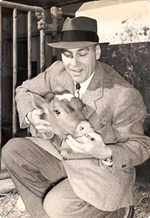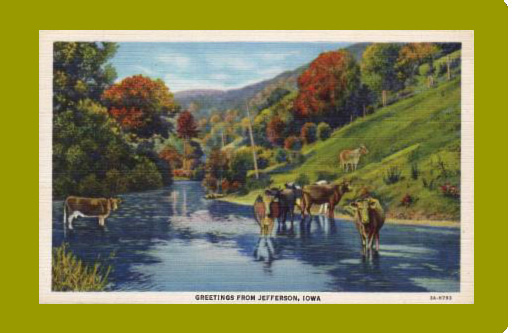 George Gallup's forbearers, after arriving in
America in 1630, lived for eight generations in
Stonington, CT. It was Gallup's grandfather, John
Gallup, who moved from Voluntown, which is near
Stonington, to Mendota, Illinois where he joined the
Northern Army, and then after the Civil War, came
eventually to the town of Jefferson, Iowa. He
had heard the wonderful stories about the free and
fertile land in Iowa that was available that could
be homesteaded or bought for a very few dollars per
acre, so he moved his family on to Jefferson.
George Gallup's forbearers, after arriving in
America in 1630, lived for eight generations in
Stonington, CT. It was Gallup's grandfather, John
Gallup, who moved from Voluntown, which is near
Stonington, to Mendota, Illinois where he joined the
Northern Army, and then after the Civil War, came
eventually to the town of Jefferson, Iowa. He
had heard the wonderful stories about the free and
fertile land in Iowa that was available that could
be homesteaded or bought for a very few dollars per
acre, so he moved his family on to Jefferson.
The first year in Greene County, John and his wife, Happy Kinnie (Ted's grandparents), lived on a farm belonging to a man called George Eagleson, on the outskirts of the newly-incorporated community of New Jefferson. The following year, in 1880, they moved to their own farm in nearby Hardin Township. Here they stayed for 12 years. Then, in 1892, after their three sons had become adults, and taken up their life's work, John and Happy Gallup moved to a farm close to Jefferson.
Edgar, the oldest son, owned and ran a prosperous grocery store (Gallup's Grocery Store) in Jefferson (where Ted Gallup worked during vacations.) Joseph became a lawyer, while George, the youngest, taught school (he was Principal of what was called "Gallup's school) and then became co-proprietor of the Jefferson Carriage Works, described in Iowa Illustrated in 1896 as "one of the most extensive business concerns in the city." The article also notes: "the proprietors, Messers. George H. Gallup and Wm. H. Burk are two wide awake gentlemen who have by their honorable business methods and strict attention to the wants of their patrons, built up a very extensive trade. They handle a large stock of buggies, carriages, surreys, road cars, spring wagons and bicycles.
Ted's father was a well-read and scholarly man, constantly wrestling with new ideas and concepts. He was fascinated by the workings of the mind, and persistently worked on one main idea all his life - a system of logic, that presaged much of what was done later in this field.
George Henry Gallup was a realtor and land investor with his real estate ventures extending far and wide - from Jefferson to Montana, where he once purchased no less than four square miles of land near Big Timber. He also owned land in Kit Carson, Colorado. His holdings in Jefferson included two large buildings on the town square, one the Lincoln Hotel, the other a building which housed his real estate offices. Another of Gallup's projects was "Sunnyside Acres," a section of Jefferson which he divided into lots.
George Henry Gallup was, in fact, one of the foremost town-builders. Those who enjoy Russell Park with its towering maples can thank George Gallup's efforts of a century ago. And there are certain streets in Jefferson that are lined with trees planted by the two Gallup boys - Ted and his older brother, John. (There were four Gallup children, Edna, the oldest, followed by Gladys, John and then Ted.)
George Henry Gallup not only brought beauty to the community, but culture as well. He was instrumental in raising the funds to build the Carnegie Library and to acquire land for the Chautauqua Circuit lectures which came to Jefferson for many years in the early part of the century.
One of Gallup's pet projects, however, came to naught. When the community was considering building a new courthouse in the middle of the town square, Mr. Gallup pleaded for a structure which would preserve the trees and not overshadow the other buildings on the square. He fought hard for his plan - four small buildings, connected by colonnades - but it was too advanced a concept for the town fathers and he lost his case.
In keeping with his constant desire to try something new, the senior Gallup, in setting out an orchard on his property, removed all the top soil so that the trees would grown in the underlying lay and grow more slowly, on the theory that a tree that matures more slowly will bear more fruit. He also developed a scheme by which, not only to get more fruit, but also to have fewer limbs on trees - the dwarf tree concept.
Gallup also proposed that silos be built into the ground instead of sticking above the ground, thus causing less spoilage and being easier to drain. Furthermore, in one of his many pamphlets he propounded a new way of selling groceries - through boxes kept in homes which would be replenished by the deliveryman when a certain staple was exhausted.
Ted's father was vitally interested in the education and character development of his children. He built a library in their house which was stocked with more than 1,000 books, so there was no need to go to the local library, although the library was regarded as excellent.
The senior Gallup, in a major way, helped to develop Jefferson both physically and culturally -- a community he revered, as seen in a promotional pamphlet he distributed in 1903, with an accompanying map. Announcing that he had 100 farms for sale in Greene County, he wrote enthusiastically:
Nearly every farm has a grove on it, which gives a pleasing, home-like look, the improvements are generally good, consisting of a farm house, barn, granaries, and corn cribs, stock sheds, and other small buildings. All the farms are fenced and cross-fenced, and most of the low land is tile drained.
Jefferson, the county seat, is situated in the center of the county, at the crossing of the Northwestern and Milwaukee roads. This is the prettiest town to be found in Iowa. It has a population of over 3,000 and is filled up with retired farmers who have become independently rich farming Greene County land. It has fine schools and churches of all leading denominations.


